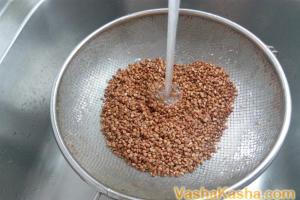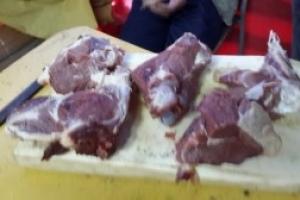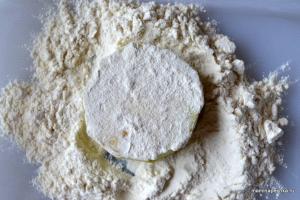Genus Erika has quite a lot of species (more than 400), most of which are garden plants.
But some species can also be used as house plants - however, it is preferable to grow Erica, for example, on a balcony or loggia, since the indoor microclimate is not entirely suitable for it.
The most common for home floriculture Erica varieties:
Erica graceful (Erica gracilis),
Erica grass or ruddy (Erica carnea).
In appearance, Erica is a small evergreen shrub with small, needle-like leaves of a soft green color.
The stems of the plant are long, rigid, and erect. At the end of autumn and beginning of winter, Erica blooms - its flowers are tiny, bell-shaped. U different types various shades of colors - pink, lilac, crimson, white, red.
Brief information - dossier on the flower
| Erica |
|
| Africa, Europe | |
| Complex | |
| In the apartment - well lit, outdoors - partial shade | |
| Up to 15 °C | |
| Frequent watering with rain or soft water | |
| in spring | |
| Removing dried flowers | |
| Autumn and winter | |
| 40-50 centimeters | |
Erica needs cool, well-ventilated places, with sufficient light - under such conditions it can be grown indoors.
Quite often, Erica is grown on open balconies and in the ground as annual plant– it does not tolerate frost. However, if you enter it on glass balcony or a terrace - it may well survive the winter.
Erica needs a lot of light, but at the same time she cannot stand direct sun rays. When grown in open ground The plant is planted in semi-shade areas.
During the flowering period (late autumn), Erica needs a temperature of +7-8°C. The rest of the year optimal temperature for this plant + 15°C. Maximum temperature + 18°C. If the temperature rises, then increase the humidity level for the plant. To do this, Erica can be placed in a tray with wet pebbles.
Erica is used for watering soft water(hard is destructive for the plant). You need to water frequently - this will also help preserve temperature regime. Periodically add to water for irrigation liquid fertilizer.
The above-ground part of the plant is often sprayed, maintaining high level humidity.
You must constantly ensure that the peaty soil in which the plant is located remains moist. If it dries out excessively, then for urgent resuscitation, the pot with the plant can be immersed in water for 40-50 minutes.
An overwintered plant must be transplanted into a new pot in the spring. The soil must be peaty, acidic, without lime impurities. After landing upper layer The soil above the roots should be compacted well.
Reproduction
Erica can also be propagated by air layering.
The cuttings are cut at the end of summer and planted in a mixture of peat and sand (in the proportion of 2/3 peat and 1/3 sand). Then the planted cuttings are covered with film (bag) and kept moist at a temperature of + 18°C.
Layers are added in the spring and wait for roots to appear. After this they are separated from mother plant and planted separately.
To remove dried flowers, the plant is turned on its side from time to time and shaken.
 (Erica darleyensis) - flowers are only white, pink or purple, reach 60-70 cm in height, grow up to 1 m in width. (Erica darleyensis) - flowers are only white, pink or purple, reach 60-70 cm in height, grow up to 1 m in width. |  Erica Mediterranean(Erica erigena, Erica mediterranea) - has purple-pink flowers, the plant height can be up to 3 m, the crown diameter is 1 m. Erica Mediterranean(Erica erigena, Erica mediterranea) - has purple-pink flowers, the plant height can be up to 3 m, the crown diameter is 1 m. |  (Erica mackaiana) with pink-purple flowers grows to 15-25 cm in both height and width. (Erica mackaiana) with pink-purple flowers grows to 15-25 cm in both height and width. |
Diseases and pests
If Erica drops leaves, this means a lack of water, humidity and too much high temperature. Excess water can cause roots to rot.
Of the harmful insects, Erica can be attacked by scale insects and mites. To remove insects and waste products, the stems and leaves of the plant are wiped with a cotton swab dipped in alcohol. Then the diseased plant is treated with appropriate insecticides (against ticks - acaricides). When treating Erica against ticks, frequent spraying of the plant also helps.
Acquisition
When purchasing, make sure that most Erica flowers are unblown.
Purchasing plants: when choosing Ericas for your garden, make sure that the plants you like are obtained as a result of propagation of a proven variety that is stable in the given conditions (those called zoned varieties), or, if the plants are imported, resolutely refuse those brought from Central Europe: they even if they survive, they will freeze over every winter and will not show their full potential. Material from the north of Germany and Poland, from the Baltic states and from the Scandinavian countries is the most reliable.
Eriks have a symbiosis with the mycelium of soil fungi and, if the roots that provide the symbiosis are damaged, they take root very poorly. This happens more often if the plant has bare roots - an open root system. In case of long or improper care such a plant dies very quickly, but does not lose leaves and flowers (this is a feature of Eric). When purchasing heather, you should pay attention to the fact that the plant in the container meets the criteria set out for heathers:
appearance of the plant: shoots should be elastic, well-leafed, at the ends of the branches there should be vegetative buds or young shoots that are significantly lighter than the old ones;
soil in which the shrub grows: the soil should be slightly moist, not too dry, but not wet. Excessive moisture can lead to rapid death of the root system;
container in which the shrub is located: it is very good when the pot fits tightly to the root ball; in this case, air will not flow to the roots, drying them out.
Location: To maintain the intense color of the flowers, Ericas need full sun. In shade or partial shade, the flowers turn pale and their number noticeably decreases. The location should be protected from wind. As protection from strong winds, evergreen coniferous plants or hedges of spirea, cotoneaster, mahonia, etc. should be planted.
Soils: Erica ruddy tolerates almost neutral soil (pH up to 6.5), Erica Darleyen requires acidic soils (pH from 4 to 5), Erica four-dimensional prefers humus acidic soils (pH from 3 to 5), Erica wandering tolerates slightly alkaline, but prefers sour ones. The mixture includes peat, sand and turf soil in equal quantities for neutral soil or 3 parts peat if the soil should be more acidic.
Landing: distance between plants 0.4-0.5 m in groups, per 1 sq. m, 5-6 specimens are planted. Planting depth is 20-25 cm, only to the level of the root collar. Optimal age for boarding permanent place 2-3 years. Planting time: early spring before flowering or immediately after flowering. They can be planted from containers in the summer and early autumn after pruning, after keeping the plant in a basin of water for 1-2 hours or watering it abundantly. Drainage is preferably small made of sand.
Care: during planting, after pruning and before flowering, mineral fertilizers are applied at the rate of 30 g/sq. m of Kemira-universal, containing both macro- and microelements. To avoid burning tender shoots, you should scatter fertilizer by lifting the branches. Abundant watering is necessary after planting: 4-5 liters per bush. In dry and hot summers, it is recommended not only to water frequently, but also to spray the plants in the evening. Due to the shallow root system, surface loosening up to 3-6 cm is allowed when removing weeds and compacting the soil. When mulching, wood chips, pine bark and peat are used. A layer of mulch is 5 cm. It is better not to prune young plants, but old plants (age 10-15 years) are pruned immediately after flowering, removing part of the stem below the faded inflorescences. In Moscow, this work is recommended to be carried out at the end of May or at the beginning of June. At the end of June - in July, new buds are formed, and pruning of shoots is not allowed.
| Erika grass under the snow | ||
Wintering: late autumn It is recommended to add peat or dry leaf to the tree trunk circles in a layer of up to 10 cm. It is better to cover the top of the plant with spruce branches, which is, in particular, convenient for carpet planting. Using this old “old fashioned” method, you can kill three birds with one stone. The first “hare” - spruce branches really creates more or less reliable protection from frost; second - under spruce branches, plants do not get wet from condensation, as under denser shelters, and continue to “breathe”; and, finally, the third “hare” - in the spring with spruce branches The needles will fall off the moment you remove them. This mulch is very beneficial for heathers, as it slightly acidifies the soil. It is also useful to chop the fallen branches into smaller pieces and scatter this material between the plants. In mid-April, the shelter must be removed and the peat must be raked away from the root collar to ensure full flowering.
Diseases and pests: Ericias are practically not damaged by pests, but fungal and viral diseases are possible.
The most common disease is gray mold, which develops at high air and soil humidity. This usually happens in places where a large mass of snow is retained, or in places that do not have meltwater runoff. Plants that were not covered correctly or the cover was removed too late are also damaged. When the first signs of the disease appear (gray bloom on the shoots, partial death of young shoots and falling leaves), it is recommended to use antifungal drugs such as “Topaz”, “Fundazol”, with more severe damage to the plant, a 1% solution is used copper sulfate. Treatment is carried out in 2-3 doses with an interval of 5-10 days. Preventive treatment is carried out in late autumn or in early spring, after removing the cover from the bush.
If the leaves turn brown and the tops of young shoots wither, this is most likely a consequence of waterlogging or excessive fertilization. Possible defeat Eric powdery mildew, in which young shoots dry out and the leaves become covered with a grayish-white coating. Antifungal drugs are used to treat affected plants. Sometimes red-brown spots appear on the leaves, indicating rust damage.
Symptoms of a viral disease are deformation of shoots and flowers, uncharacteristic, uneven coloring of foliage and flowers. Viral diseases are quite well studied, but effective treatment No. In case of viral infections, the plant must be dug up and burned.
Reproduction: seeds (species), cuttings (varietal), dividing the bush, both.
Propagation by seeds. The seeds are small, and it is better to sow them indoors in bowls or bags, without planting them in the soil. Cover with glass until shoots appear. The best substrate for growing: coniferous or heather soil, peat and sand in a ratio of 1:2:1. The favorable temperature for their growth is 18 - 20°C. Shoots appear a month after sowing the seeds. The first week it is necessary to maintain high humidity. In the summer, boxes with seedlings are taken out into the garden, grown, hardened, and after 1.5-2 years they are planted in a permanent place: alpine slide, flower garden, along the path, etc.
Erica arborescens seeds, when stored in hermetically sealed containers, remain viable for up to 15 years. Laboratory germination is 65%, soil germination is 30-35%. Embedment depth c. 0.4-0.9 mm.
Under natural conditions, the seeds of Erica glaucosa do not spread far from the mother plant. After 2 years of storage in dry conditions. germinate normally, but a 10-week storage period in humid conditions improves germination. Soil germination rate is 20-40%. Light and variable temperatures significantly affect germination. Monthly wet storage c. at 1 °C, hot treatment (shock) for 1 min at 80 °C and mechanical scarification also significantly stimulate the germination of c. (germination rate 40% after 4 weeks, in control only 3%). Embedment depth c. 0.5 mm, surface seeding.
Apical cuttings can be taken early in spring before flowering or a month after flowering. Very soft cuttings are not suitable, as they wither faster and are damaged by diseases. The length of the cutting is 2-3 cm. One third of it is immersed in the substrate. They are rooted in sphagnum peat with sand, preferably in separate pots, where the root system is well formed. Regular foliar feeding is required for weak urea solution, as well as microfertilizers. The formation of roots depends on temperature and variety and usually begins 3-4 weeks after immersing them in the soil mixture, on top of which 1 cm of washed sand is applied. Rooted cuttings grow faster and bloom earlier than seedlings.
Erica can also be propagated by dividing the bush. Dividing plants into parts is carried out with a sharp shovel. Good roots form on the separated plant parts. They soon become full-fledged specimens. Film greenhouses and beds covered with various covering materials allow you to quickly grow good planting material. Ericas can live in the garden for 15-20 years, decorating compositions.
Usage: Ericas can be used as ground cover plants. The great variety of flower colors in Erica varieties will allow you to create a bright carpet in your garden plot. The combination of colors can be different - you can create gentle transitions from lilac through purple-pink to soft pink. You can use white to separate different groups of brightly colored flowers. When creating heather corners, you need to keep in mind that varieties of Erica rosy and Darleyen bloom immediately after the snow melts in April-May, while varieties of Erica four-dimensional bloom later - from mid-June to mid-late July.
Partners: Erica varieties can be used either separately to create flowering spots in the consecrated corners of your garden, or in combination with other heathers and, above all, rhododendrons. All heathers look great with low-growing forms of conifers: junipers, thujas, cypresses, yews. From herbaceous plants Cloves, thyme, and ornamental grasses are suitable.
| MONTH | ACTIVITY |
| March |
Preparation garden tools and inventory. |
| April |
Removal winter shelter, raking peat from the root collar of last year's and old plantings. In case of “bulging” of roots, plant the plants in their original place. Removing dry and damaged shoots from plants. First fertilizing with nitrophoska before flowering. |
| May |
Watering and sprinkling in dry weather. Application of fertilizers (Kemira-universal) to the soil. At the beginning of shoot regrowth, foliar feeding is carried out. If the plants are weak, it is recommended to spray 2.5 cm 3 of epin per 10 liters of water. Preventive spraying of plants against pests and diseases (if there is excess moisture in the soil and air for a long time). |
| June |
Weeding. Loosening tree trunk circles. Formative pruning after flowering. The third fertilizing with mineral fertilizers after the end of flowering. Cutting cuttings for green cuttings. |
| July |
In the first half of the month - the last fourth feeding. Removing weeds and loosening as necessary. |
| August |
Watering. Weeding. Loosening the soil during its compaction. |
| September |
Autumn planting. |
| October November |
Mulching with peat or dry leaves. In the first half of November, cover young plants with spruce branches, and heat-loving varieties with covering material, which is stretched over the frame so as not to touch the plants. |
Erica plant is a beautiful evergreen herbaceous or tree-like shrub of the heather family with narrow bright green needle-shaped leaves and small bell-shaped flowers.
The color of the flowers varies from snow-white and pink to red and purple. The flowering is so abundant that the leaves are not visible. Thanks to its unpretentiousness and attractiveness, Erica is loved by gardeners.
Grow it in open ground and in pots. Erica propagates vegetatively and by seeds.
The seedlings are planted on the site immediately, and from the seeds Erica is grown in room conditions, and only a year later they are planted in open ground.
- Rosy (herbal) is a shrub up to 60 cm tall, blooms from April. The color of the flowers is pink, reddish, rarely white.
- is a hybrid of Erica ruddy, the height of the plant is up to 50 cm. It is distinguished by good winter hardiness and a long flowering period. Flower colors range from white and lilac-pink to purple-pink and violet.
- – grown more often as a potted crop. Blooms reddish, snow-white and pink flowers several months starting in November.
- – reaches a height of 20 cm, blooms with red flowers from April.
All these types of Erica are propagated by cuttings or seeds.
Planting a flower on the site
Erica is planted in a permanent place in the spring. before or after flowering. Choose a place that is sheltered from drafts and well lit. Without direct sun, the color of leaves and flowers fades.
Erica prefers light, breathable, acidic soil. Therefore, peat and sand are added to the soil.
Erika water stagnation can't stand it, it needs to be planted in places where there will be no piles of melted snow in the spring. When planting potted crops, good drainage is needed.
Plants are planted at a distance of 50 cm, maintaining a planting density of 5-6 bushes per 1 sq.m. Planting depth is 20-25 cm, the root collar is not buried. For good rooting and growth, the plants are watered every other day or two for the first couple of months.

Care
Plant roots are shallow, so loosen the soil superficially, to a depth of 6 cm.
You can mulch the soil with peat, pine needles, sawdust or bark in a 5 cm layer. Mulch acidifies the soil, prevents the proliferation of weeds, conserves moisture and ensures a safe wintering.
Top dressing
Fertilize Erica when planting bushes, before flowering, and also after pruning. scattered under bushes or added to water when watering. They are fed with complex mineral fertilizers, such as Kemira-universal (20-30 g per 1 sq.m.), fertilizers for rhododendrons or azaleas, but in smaller dosages.
Erica should not be fertilized with fresh organic matter.
Watering
Although Erica is drought-resistant crop, the soil should not be allowed to dry out. Water with warm soft water and spray occasionally.

Trimming
Bush pruning provides rich flowering and improves bushiness. Lignified branches do not form new shoots, so after flowering the part where the leaves grow is cut off.
Pruning is carried out asymmetrically - it gives the bushes a more attractive natural look.
Wintering
The trunk circles of the bushes are covered with a layer up to 10 cm dry leaves or peat. The plants are covered with spruce branches: it protects from cold, prevents condensation and acidifies the soil with pine needles.
Reproduction
By cuttings
Erica is propagated by apical cuttings before flowering or a month after it.

The cuttings are cut 2-3 cm long and planted in an earthen mixture of 2 parts peat and 1 part sand, deepening 1/3 of the length into the ground. Sprinkle the soil on top with a 1 cm layer of sand.
Pots with cuttings are covered with polyethylene or glass and kept at a temperature 18-20 degrees shading from the sun. Regularly fertilize with microfertilizers and a weak urea solution. After 3-4 weeks, the seedlings should take root.
By layering
In the spring they choose strong shoots, tilted to the loosened soil, attached with wire or a pin, and covered with earth.
The soil is moistened without allowing it to dry out. When the shoots take root, they are carefully separated and planted.
Seeds
To sow seeds, prepare an earthen mixture of heather, coniferous soil and sand (in a ratio of 2:1:1). The seeds are small, they are not covered with soil, but only slightly pressed against the soil. The soil is moistened with a spray bottle, and high humidity is maintained for a week.
The container is covered with glass or polyethylene, the temperature is maintained at 18-20°C, and ventilated daily. Shoots will appear in a month.

Propagation by seeds labor-intensive, therefore it is rarely used and mainly for natural plant varieties.
Dividing the bush
An old adult bush is dug up, divided into parts with a knife or shovel and planted.
Diseases and pests
Fungal diseases:
- Gray rot— a gray coating appears on the branches, the plant sheds its leaves, and the branches partially die off. The reason is high humidity.
- Powdery mildew- young branches dry out, and the plant becomes covered with a white-gray coating.
- Rust– red-brown spots form on the leaves.
 When Erica is infected with gray rot, the branches die
When Erica is infected with gray rot, the branches die It is recommended to spray with antifungal fungicides such as Topaz or Fundazol, and in severe cases with Bordeaux mixture or a 1% solution of copper sulfate. After 5-10 days the treatment is repeated.
At viral As a result of the disease, flowers and shoots are deformed, the color of buds and foliage changes. Unfortunately, there is no treatment for this disease; the bushes will have to be dug up and burned.
In case of defeat scaleworm and spider mite a cotton-like coating and cobwebs appear on the bushes on the underside of the leaves, the foliage becomes deformed and turns yellow. It is recommended to treat with fugincides, for example, "" or "Aktellik"
Use of landscape design
Erica is used in single and group plantings, as ground cover plant and as a potted plant for decorating verandas and windows.
Decorative and organic Erica bushes look great in company with barberry, heather, cereals, decorative ground covers, Japanese spirea, and low-growing conifers.
Erica branches are used to form winter bouquet. Cut branches are dried in a vase. To prevent shedding, flowers are sprayed with hairspray.
Completely easy to care for, but amazing ornamental plant will decorate the garden and delight you with its palette of colors most of the year.
In the garden, the first flower that heralds the arrival of spring is Erica, a plant belonging to the heather family. Its color palette is very diverse. Many varieties bloom profusely and for a long time. For all these qualities, gardeners love Erica. Another quality that the flower is endowed with is unpretentiousness, so even novice gardeners can grow it.
general characteristics
A large number of varieties of Erica look like evergreen shrubs
. They are very similar to heather. On the long stems there are small needle-shaped leaves, the length of which is approximately one centimeter. They are very similar to spruce needles, growing at right angles to the shoot.
When the time of flowering comes, the bush becomes strewn with abundant small flowers. In shape they resemble bells, which are slightly elongated and drooping. They are collected in one-sided brushes of various colors. They can be white, pink, purple, etc. The color remains unchanged for a long time even after flowering has ended.
After flowering fruit boxes are formed, which are filled with tiny seeds. They can remain viable for several years.
As garden plant Erica was first used in England around the mid-eighteenth century. After this, Holland and Belgium began to develop new varieties. As a result, many hybrid varieties of shrubs have appeared. Currently, the plant is grown both in open ground and in pots or decorates terraces. It is unpretentious and many gardeners love it for this.
Flower varieties
The Erica plant has in the description wide variety of species. However, the most interesting for gardeners are:
- Erika herbaceous is one of the very first to bloom. Sometimes it is also called ruddy. Around April, everything is already covered with small bells of reddish or pink shades. The bushes can reach up to thirty centimeters in height, and some specimens even up to fifty. From this group we can distinguish the following varieties: Erika herbal Miratown ruby, Natalie, Ice Princess, Isabelle, etc.
- Erica graceful (gracilis) - most often this culture is used as potted plant. The flowers begin to bloom around November and last for several months. There are several varieties of this variety and their main difference is color palette: Their flowers may have a white, pink or reddish tint.
- Erica Darlenskaya is a hybrid species that was bred by the English breeder Darley Dale at the beginning of the twentieth century. Currently, it has become widespread throughout Russia. It is characterized by winter hardiness, which is very important for the cool Russian climate, and a long flowering period. About twenty varieties belong to this group of shrubs. The tallest can reach half a meter in height.
- Erica pink is the shortest of all species. In rare cases, the plant grows up to twenty centimeters. Usually it is much lower. It blooms around April and has bright, dark red flowers.
- Erica arborescens is an unpretentious shrub that can grow in any type of soil. It has a curved trunk and pretty white bell-shaped flowers, the anthers of which are painted bright red. This type of plant is characterized by a very fragrant aroma, and the height of some specimens can reach seven meters.
Erica's landing
 When landing very it is important to choose correct soil
. Heather shrubs prefer soil with high acidity, which can even be very acidic. The soil itself can be swampy or dry sandy. Regardless of where the plant is planted - in a pot or in a hole in open ground - there must be a layer of drainage at the bottom, because stagnant water is harmful to the flower.
When landing very it is important to choose correct soil
. Heather shrubs prefer soil with high acidity, which can even be very acidic. The soil itself can be swampy or dry sandy. Regardless of where the plant is planted - in a pot or in a hole in open ground - there must be a layer of drainage at the bottom, because stagnant water is harmful to the flower.
When planting in open ground, the distance between bushes should be maintained. It should be approximately 40 or 50 centimeters. Plant bushes to a depth of 20-25 centimeters. In this case, the root collar should not be deepened.
It is better to leave Erica in one place for two or three years, after that you should find her a new place. It is better to plant it before it starts to bloom or after flowering.
The soil must be breathable and allow moisture to pass through well. As a substrate a mixture of:
- peat, coarse sand and turf in proportions 3:1:1; when selecting neutral soil, the peat part can be reduced;
- sandy forest soil; rotted pine needles; peat and river sand (proportion 3:1;1;2)
Required care
Caring for heather shrubs is not at all difficult, which is why it is so often chosen for planting and decorating the garden. Required follow some simple rules:
- Lighting and location selection. The shrub prefers to grow in a bright place, but the light should be diffused. When it grows in a shady location or where partial shade is present, the color of its flowers may become paler. Their number may also change downward. In addition, it is desirable that there are no drafts at the planting site. It’s good if there are hedges nearby that protect the bushes from the wind. At home, pots can be placed on southern, western or eastern window sills. If selected a good place, then Erica will definitely please the owner with abundant and long-lasting flowering.
- Temperature regime. This point applies more to those flowers that are grown indoors. For normal growth, Erica requires a temperature of approximately 18 degrees. During the flowering period, it should be about half lower - about 7-8 degrees. If it rises, then it is necessary to increase the air humidity. When temperatures are above 21-22 degrees, it is recommended to install humidifiers or place the pot in a container containing wet ceramite. You can also spray the deciduous part of the crown.
- Watering mode. It is necessary to water the bush with a soft type of water, without the presence of impurities. Hard water can destroy a flower. In summer, more frequent watering is required. However, the soil should not be over-moistened. If the soil in the pot is too dry, then it is better to place it in a container with water and keep it there for about forty minutes.
- Shrub trimming. During the first two years after planting, the bush does not need pruning. Then, in most cases, formative pruning is required. It is necessary to carefully remove excess shoots, forming a crown. It is better to do this after the flowers have faded or before the active growth after a period of rest. When pruning, it is important not to remove old wood.
- Feeding. From time to time the plant needs feeding. However organic fertilizers It is not recommended to apply it in the form of fresh manure. For these purposes, mineral minerals are used. complex fertilizers. Special additives intended for azaleas or rhododendrons are also suitable. They can be found in flower shops. In this case, the dosage is slightly reduced. When fertilizing, fertilizers are applied to the soil, but care must be taken that the solution does not get on the foliage, otherwise it may cause a burn. There is no need to fertilize the flower often; it is enough to do it once a year. spring period, adding mineral composition in water.
Plant propagation
Erica is propagated in several ways. These include:
- cuttings;
- propagation by layering;
- seeds.
 When cuttings, cut the cuttings 2-3 centimeters in length. Then they are planted in a soil mixture (2 parts peat soil and 1 part sand) and deepened 1/3 into the ground. The resulting seedlings are sprinkled with a layer of sand about a centimeter thick on top.
When cuttings, cut the cuttings 2-3 centimeters in length. Then they are planted in a soil mixture (2 parts peat soil and 1 part sand) and deepened 1/3 into the ground. The resulting seedlings are sprinkled with a layer of sand about a centimeter thick on top.
After the procedure, containers with planted cuttings should be covered with film or glass and placed in a place where the air temperature will be approximately 18-20 degrees. They should be shaded from the sun. In about a month, the seedlings should take root. All this time they need to be fed with microfertilizers or use a weak urea solution.
Reproduction by layering begins in the spring. At this time, stronger shoots are selected from the bush and tilted towards the ground. Then they need to be secured in this position. Wire is suitable for this. They need to be sprinkled with soil on top and moistened. After some time, they will take root and can be planted separately.
The seed propagation method is the longest and most labor-intensive. To sow them, you need to prepare special soil, which should consist of heather soil, coniferous soil and sand (2: 1: 1). The seeds are very small, so they are not planted in the soil, but sprinkled directly on the surface, slightly pressing them to the ground. After this, you need to moisten them with a spray and maintain high humidity. It is also necessary to cover them with glass or film and maintain the temperature at 18-20 degrees. After a month, the first shoots should begin to appear.
If the bush is already old, then it can be propagated by dividing the bush. To do this, you should dig it up and simply divide it into several parts, and then plant these parts again.
Possible difficulties
Sometimes the plant is affected various diseases. Fungal scourges include:
- Gray rot - with it, the branches become covered with a gray coating, the bush begins to shed its leaves and some branches die. This happens when humidity is high.
- Powdery mildew - appears on the bush white coating, and young branches die.
- Rust - brownish-red spots form on the foliage.
If diseases caused by a fungus appear on the bush, it should be treated with fungicidal agents according to the instructions. Fungicides also help with mealybugs or spider mites.
If the cause of the damage is a viral disease, then flowers and shoots are subject to deformation, and the color of foliage and shoots may also change. In this case, it is no longer possible to help the plant, therefore, in order not to infect other plantings, the diseased plant should be dug up and burned.
Erica is the name flower of the famous singer and is considered a relict plant. This is one of the many representatives of the Heather family, which in turn has many species. We will talk in more detail about all the subtleties and features of the Erica plant, as well as about the rules for growing and caring for flowers in the garden in this article.
Erica: plant description

Erica is a plant with quite an interesting appearance, the description of which is as follows: bush small size(up to 30 cm), evergreen. Small leaves (up to 1 cm in size) are needle-shaped and “scattered” along the entire length of the stem. The stem is rigid, erect and quite long.
Like other members of the Heather family, the "Erica" plant blooms small flowers, similar to bells with their heads lowered, collected in a small one-sided brush. The color of the flowers varies depending on the species and can be either snow-white or deep purple.
Did you know?Inexperienced flower growers believe that Erica and heather- the same thing, but these two plants have a very significant difference: Erica- evergreen.
Erica shrub comes from South Africa, and the plant was cultivated for the first time in England, in the middle of the 18th century, and since then it has become popular in Belgium, Holland and other countries. Erica came to our area from Germany in 1994. Now in cultivation different ways: And How indoor plant, and as a decoration for the garden.
Main types of Erica
Despite a large number of Erica species, gardeners focus their attention on a few basic ones that can easily be grown at home. They all differ in size and color.
Erica rosy or herbal
 Erica carnea L. = E. herbacea - ruddy or herbal Erica. Most often found in southern and central Europe.
Erica carnea L. = E. herbacea - ruddy or herbal Erica. Most often found in southern and central Europe.
- shrub growing up to 65 cm in height and up to 40 cm in diameter. Its crown is branched, the leaves are bright green, 4-8 mm in size, glossy, needle-shaped, arranged in a whorl of 4 pieces.
The flowers are drooping, bell-shaped, collected in racemes and located in the axils of the leaves. Brush size - 2-5 cm. Flowers red or pink flowers, less often - white color.
Important!The flowering period of the plant depends on the area of growth: in Russia this process begins in late April-early May, but the further south the territory, the earlier Erica herbacea will bloom (possibly even in March).
The most common type of herbaceous Erica is the Erica Alba species, which has become the basis for many hybrid varieties.
- plant up to 50 cm high with an uneven crown: side shoots shorter than the central ones. The leaves are linear, colored light green, growing no more than 4 mm. The flowers are oval-shaped, elongated, bright red. They are collected in small inflorescences of 4 pieces at the tip of the shoot.
 Erica graceful begins to bloom in October and ends in February. Many varieties of this species differ in color: they can mainly be pink or white.
Erica graceful begins to bloom in October and ends in February. Many varieties of this species differ in color: they can mainly be pink or white.
Did you know?Erica Graceful is most often grown as an annual indoor plant.
Erica gracilis is propagated vegetatively by rooting cuttings in acidic, nutritious soil.
The plant does not require Erica special care:This species needs good moisture, a warm and well-lit place.
It looks good next to cyclamen and chrysanthemums, and special stones or decorative roots can be used to decorate a pot with Erica.
- a shrub with a highly branched crown, which in nature can grow up to 90 cm, but when grown at home - no more than half a meter.  Erica Darlenskaya is a hybrid that combines several varieties that begin flowering in late April or early May.
Erica Darlenskaya is a hybrid that combines several varieties that begin flowering in late April or early May.
In addition, this species is characterized by rapid growth, which attracts many gardeners. The color of the flowers varies and, depending on the variety, can be snow-white, pink, or dark crimson.
Some of the varieties tolerate only light frosts and are not frost-resistant.
Erica does not require much effort in the process of care, and growing in general is quite simple. It is enough just to water the plant in time, spray and feed it. Also for this species it is better to choose well-lit places sheltered from the wind.
Where is the best place to plant Erica?
 When choosing a place for Erica, it is necessary to take into account the fact that in natural conditions the shrub grows on well-drained and breathable soil, which means that similar conditions must be ensured in home growing, because stagnation of water in the root system can lead to flower diseases.
When choosing a place for Erica, it is necessary to take into account the fact that in natural conditions the shrub grows on well-drained and breathable soil, which means that similar conditions must be ensured in home growing, because stagnation of water in the root system can lead to flower diseases.
As for the location, the plant does not tolerate direct sunlight, therefore, it is better to choose a well-lit but cool area.
Based on this, Erica will feel great on an eastern or east-west window.
The soil should be acidic, with a pH level of 3-4. The best soil for Erica is consisting of turf, peat and sand.
Growing Erica
Growing Erica is a simple process, but everything needs to be done comprehensively, following the rules of planting, watering, fertilizing and wintering the plant. We'll talk more about this later.
How and when to plant Erica
It is best to plant Erica with the onset of the first warm days, when the temperature outside stabilizes around +10 °C. This is the main condition, the observance of which will help the plant grow stronger before winter.
If you plant Erica in the fall, the shoots will freeze, or, in the worst case, the plant will die. Usually, when planting, soil remains on the roots, therefore, before planting, it is necessary to moisten them well. 
Erica Reproduction
Erica can be propagated vegetatively, using cuttings, or using seeds when propagating natural varieties.
Important! Hybrid varieties It is better to propagate vegetatively, since when propagated by seed, they may not retain the varietal characteristics of the “parent” plants.
Propagation by cuttings easy to carry out. The best period for this procedure is the end of summer.The cut cuttings must be planted in a mixture of peat and sand and created a “wig effect” by covering the container with glass or film. In this state, the cuttings remain until spring. Periodically, the film needs to be removed and the planted plants must be “ventilated,” as well as the soil must be moistened with a spray bottle.
By spring, layering will appear that need to be buried. When the root system is sufficiently developed, the plants can be planted in pots.
 Reproduction by seed method
happens as follows: Erica seeds are sown on the surface of a soil mixture consisting of sand, coniferous soil and heather soil (there is no need to deepen them very much). The sown seeds must be placed under glass or film and wait for the first shoots to appear; this process usually takes about a month.
Reproduction by seed method
happens as follows: Erica seeds are sown on the surface of a soil mixture consisting of sand, coniferous soil and heather soil (there is no need to deepen them very much). The sown seeds must be placed under glass or film and wait for the first shoots to appear; this process usually takes about a month.
The optimal temperature is +18 °C...+20 °C.
Did you know?Sown seeds should not be watered, and the process of moistening the soil should be carried out carefully by spraying the container.
When the seedlings reach a size of 8-10 cm, they must be planted in pots and protected from direct sunlight. For winter, young plants should be placed in a cool place with a temperature of +10 °C...+11 °C.
How to care for Erica
Caring for Erica consists of proper and timely watering, pruning, as well as regular feeding of the plant. Watering is carried out only with soft water, since hard water can harm the plant. If you water Erica in a timely manner, you can avoid many problems.
 For example, if the soil is constantly moist, then maintaining the temperature and humidity levels is much easier. Spraying must be done with water room temperature, several times a week.
For example, if the soil is constantly moist, then maintaining the temperature and humidity levels is much easier. Spraying must be done with water room temperature, several times a week.
Important!If it happens that the soil is too dry, then the pot with the plant must be immersed in water for a few minutes.
To prevent water from stagnating, it is necessary to provide the plant with good drainage even when planting - this way you will protect it from unwanted diseases. Once every 2-3 months, liquid fertilizer can be added to the irrigation water in small doses.
It is also better to fertilize using mineral fertilizers, or fertilizers for rhododendrons, only the dosage should be lower than that indicated on the package (this will help avoid burns that can be caused by highly concentrated substances getting on the leaves). As for organic matter, it is not recommended to apply fresh manure as fertilizer.








